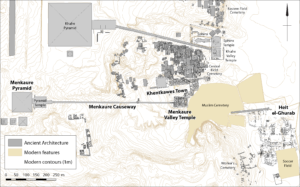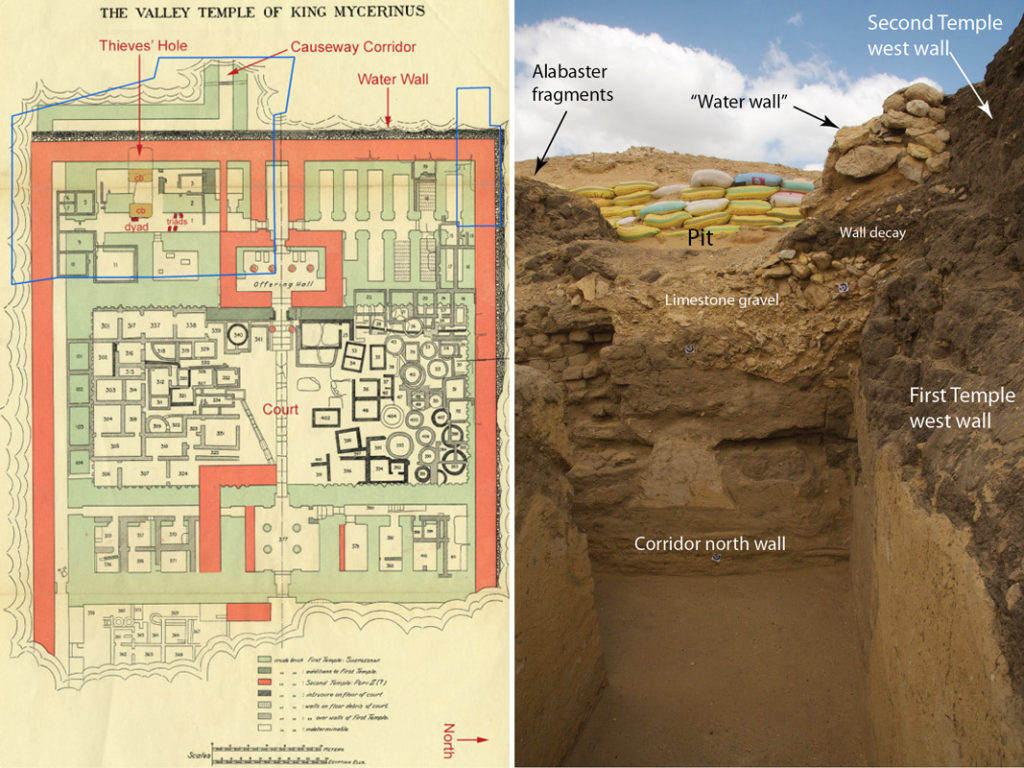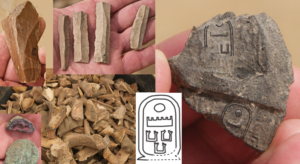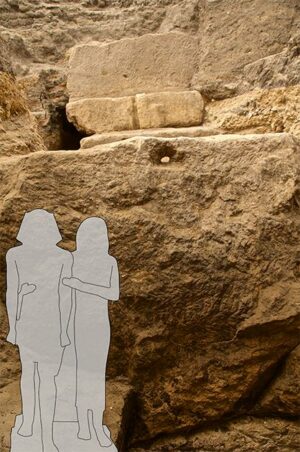AERA’s 2019 Field Season Report: New Findings from the Menkaure Valley Temple

Figure 1: The central-southeastern Giza Plateau showing the location of the Menkaure Valley Temple where we worked during 2019.
The First and Second Temples
During our 2019 Field Season, we returned to the Menkaure Valley Temple (MVT), an area crucial to our understanding of the overall settlement of the Giza Plateau. We believe that when people abandoned the Heit el-Ghurab (HeG) settlement (also known as the Lost City of the Pyramid Workers) they resettled near the Khentkawes Town (KKT) and MVT. The nature of these sites then changed from infrastructures for large royal works to service centers for the cults of the deceased kings.
George Reisner excavated the MVT between 1908 and 1910, but he never saw the whole temple exposed in phase, so his plan of the temple is reconstructed from separate exposures. It was clear to Reisner that he had two major periods: an earlier mudbrick “First Temple” (shown in green on Fig. 2) completed by Menkaure’s successor Shepseskaf and a later “Second Temple” (shown in orange on Fig. 2) built over 200 years later, probably under king Pepi II. Reisner found evidence that a desert flash flood streamed down the northern side of the causeway washing out the center of the First Temple west wall and destroying the portico and offering hall. After this event, the MVT was abandoned. Eventually, people returned and rebuilt the outer wall of the Second Temple roughly over what survived of the outer wall of the First Temple. Late in the occupation of the Second Temple, people built a fieldstone “Water Wall” against the base of the outer wall as protection against further flash floods.

Figure 2: On the left is Reisner’s (1931: plan VIII) multi-phase map with AERA’s annotations. Light green: First (4th Dynasty) Temple, orange: Second (6th Dynasty) Temple, hachured gray: an intermediate phase (5th Dynasty), black: latest domestic structures, blue lines: AERA’s 2019 excavation, cb = core block. On the right is a view from our 2019 excavations inside the MVT after Reisner’s backfill was removed.
Removing Reisner’s Backfill
A good part of our work this year went into removing and examining the deep sand and spoil that Reisner dumped into the back of the MVT and around the surrounding area as he excavated the central court. This central court area was filled with domestic structures, including many bins and granaries, which were built over time on top of each other across the court and up and over the “First Temple” walls (see Figure 2). This area was both architecturally complex and rich in material culture. A short distance north of Reisner’s excavation, we found concentrated deposits of Egyptian alabaster mixed with sand overburden, which extended north beyond our limit of excavation. These spoil deposits were rich in pottery, flint tools, animal bones, ash, charcoal, worked stone (included a diorite beard from a royal statue), pigment, wood, metal, clay sealings, and nearly 100 kg of alabaster statue fragments. Some of the alabaster fragments showed parts of hieroglyphic texts, while others showed traces of blue paint. This deposit is probably where Reisner’s workers sorted the material they found in the court. These finds were overlooked or deemed unimportant in Reisner’s time, but today there is much that we can learn from them.

Figure 3: Finds from dry sieving Reisner’s dumps from the excavations of the MVT court settlement. Left: Bones, blades, and a bit of copper. Right: Sealing fragment impressed with a seal that includes the cartouche name of Menkaure. Inset: Menkaure’s cartouche name excerpted from a sealing found in the HeG.
We have yet to fully examine most of the material we retrieved from Reisner’s backfill. However, animal bone and flint tools appear to be, by far, the most abundant material. If this material did come from the apartments in the southern side of the court, the people who stayed there cut a lot of meat. Are we finding the remains of food ritually offered to Menkaure and then consumed by people in the service of his temple? Further work in our lab may help us find out.
Descending into the Thieves’ Hole
After we had removed Reisner’s backfill, our attention then turned to what he called the “Thieves’ Hole.” This is where Reisner discovered the Menkaure dyad, before being stopped from going further by the rising ground water. Given our limited time and resources, we focused on removing Reisner’s fill within his retaining walls to reach the bottom of the hole, which gave a valuable cross-section of the stratified architecture of the temple.
As we descended we were astounded by the great depth of this part of the temple and the massiveness of the First Temple walls. We found two large limestone “core blocks,” so-called because they were meant to form the cores of the walls, which the builders would later sheath in hard granite. This is evidence that Menkaure wanted to build a stone temple, like Khafre’s Valley Temple, but the stonework stopped, probably when he died, and the temple was completed in mudbrick.

Figure 4. An outline of the dyad statue in the approximate position where Reisner’s team found it standing upright and practically undamaged on January 18, 1910. View to the west.
Further to the east inside the Thieves’ Hole, we found another large limestone core block. In front of this block is where Reisner discovered the famous nearly life-sized statue of Menkaure and a woman, probably the queen mother, standing upright and nearly undamaged (except for a chip off the king’s beard). This dyad statue, on display at the Museum of Fine Arts in Boston, is one of the most magnificent sculptures in world art history. Reisner’s explanation that the Thieves’ Hole had been “dug by treasure-hunters of the Moslem Period” and that the dyad was “apparently thrown into the hole by the treasure-hunters before they began the next hole on the west” did not add up as we now looked at the evidence 109 years later. Why would robbers leave the dyad until later and why would they sink it so deep under the temple floor? How did the dyad remain so relatively undamaged if it was thrown in?
A New Theory Emerges
Our archival research and this season’s excavations have led us to realize that Reisner did not actually find the dyad in the Thieves’ Hole at all, but in a deeper, older hole, that someone dug in ancient times a little farther east. AERA senior archaeologist Dan Jones came up with this important finding from a meticulous review of Reisner’s published report, unpublished diary, and photographs, all available at The Giza Archives.
On January 16, 1910, Reisner wrote in his diary “(n)ext to the thieves’ hole…there is another hole filled with such debris (yellow gravel) that it also must be a thieves’ hole.” In all later reports Reisner conflated the two conjoined holes, but a close study of his photographs along with our new excavation leads us to believe the Thieves Hole and the “dyad hole” are indeed different features. The older dyad hole appears to have been started from the surface of the ruins of the First Temple. That is, someone dug this hole down into the crushed limestone foundation of the First Temple during or after it fell into ruin, perhaps soon after the flash flood destroyed the sanctuary.
It now appears that the Menkaure dyad may have been buried long before the Thieves’ Hole was dug and that this older dyad hole was intentionally dug expressly for placing the undamaged statue upright, for safe keeping deep inside the temple foundations. Why this was done, and who and what the dyad represents, must await further discussion. When we return to the deep end of the MVT for our 2020 Field Season, we hope to find more answers.
Our 2019 Season was made possible thanks to the generous support of Dr. Walter Gilbert, the American Research Center in Egypt (ARCE), and AERA’s members and donors.
AERA members will receive more information on our work at the MVT in future AERAgrams. Join AERA now to help support our ongoing excavations in Egypt and you will receive these publications as soon as they are published.
